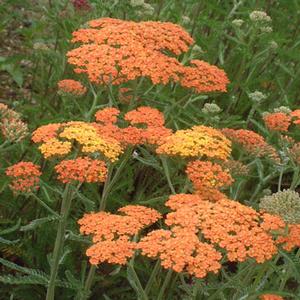Printed at http://www.newmoonnursery.com/index.cfm/
Achillea millifolium 'Terracotta'
Terracotta Yarrow
Native to Europe and Asia
FIRST IMPRESSIONS: Among the flowering plants you will find few that are as tough as yarrow. This trouper tolerates drought & commonly appears in inhospitable disturbed sites. Foliage, however, looks delicate and ferny. Bloom time is long and flowers attract beneficial insects and perfect landing pads for Butterflies and moths.
HABITAT & HARDINESS: The parent species, common yarrow is native to temperate regions of Eurasia and is naturalized in North America. It often crosses with Western yarrow (Achillea millefolium var. occidentalis). The two are almost identical and some references state that A. millefolium is really a complex of hybrids rather than a straight species.
This Sunflower Family relative occurs naturally in sunny meadow type habitats, in open woods and in disturbed sites. Common Yarrow is hardy in USDA Zones 3-8.
PLANT DESCRIPTION: Yarrow is a spreading warm season perennial with upright flower stalks. Normally height is 2' to 3' and suggested spacing is 1'-2'. Growth habit and height can differ due to variability within the species.
Yarrow foliage is finely divided and bright green with a fern-like appearance. The leaves are compound and are made of many tiny leaflets. The species name millefolium refers to the "thousand leaves" of yarrow. Foliage is aromatic and not palatable to most herbivores including deer.
White or pink flat topped flower clusters are held above the foliage. The flowers are compound corymbs that consist of 20 or more individual florets. Blooming begins in late spring and continues through the summer. Yarrow flowers are prized by floral designers for their long vase life. The blooms are attractive to beneficial insects including butterflies, bees and parasitic wasps.
CULTURAL & MAINTENANCE NEEDS: In garden situations, plants grow best in sunny exposure with well drained soil. Plants tolerate heavy clay and drought.
Yarrow is rhizomatous and can be aggressive in a good garden soil. The vigorous rhizomes can be useful if erosion control is needed. If spreading is excessive, though, maintenance may be needed to curb the growth.
LANDSCAPE USES: Common Yarrow is found most often in Meadows, Perennial Borders, Deer Resistant Plantings and Cottage Gardens. It is tough enough to naturalize on roadsides and help with erosion control on dry hills. It is a useful Cut Flower and Butterfly Nectar Plant.
COMPANION & UNDERSTUDY PLANTS: This yarrow is at home with other meadow or prairie plants such as: butterfly milkweed, rudbeckia daisies, purple coneflower and native grasses.
If this species is not available other prairie or meadow plants can be substituted.
TRIVIA: Yarrow has an interesting history in herbal medicine. It is cited most often as a topical treatment for wounds, cuts and abrasions. The mythical Greek character Achilles was reported to have taken it on campaign with his army to treat battle injuries. Hence the genus name Achillea and the old school common names "staunchweed" and "soldier's woundwort".
Fresh leaves were used to stop nosebleeds. Dried yarrow stalks are still used to consult the I Ching. In the Middle Ages, yarrow was a substitute for snuff and a component in an herbal mixture that flavored beer. It has truly been an all purpose herb.
Yarrow has recently become popular as a groundcover plant in Permaculture "Food Forest" plantings. This is probably due to the ease of culture and the fact that flowers attract beneficial pollinators.
Phytoremediation: Cadmium
Height:
2-3 ftSpread:
12-18 inSpacing:
18-24 inUSDA Hardiness Zone:
3 - 8Bloom Color:
Red OrangeAchillea millifolium 'Terracotta' Characteristics
Attracts Wildlife
- Pollinators
- Butterflies
Attributes
- Drought Tolerant
- Dried Flower
- Cut Flower
- Clay Soil
- Rock Garden
- Long Blooming
- Fragrant
Exposure
- Full Sun
Deer Resistant
- Deer Resistant
Flowering Months
- September
- August
- July
- June
Foliage Color
- Green
Growth Rate
- Medium
Juglans nigra Tolerance (Black Walnut)
- Yes
Phytoremediation
- Cd-Cadmium
Salt Tolerance
- Medium
Season of Interest (Foliage)
- Summer
- Spring
Soil Moisture Preference
- Dry to Moist

